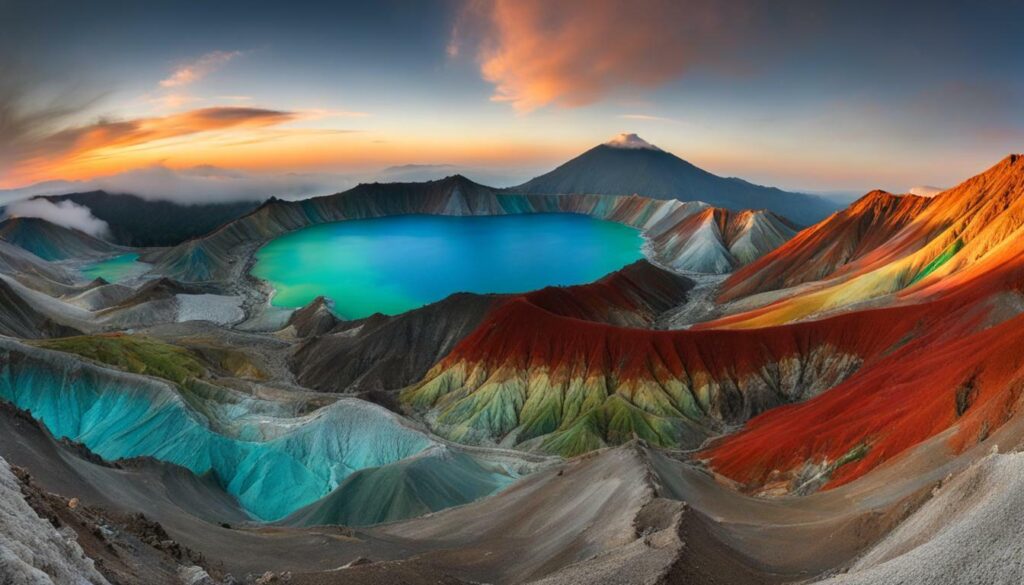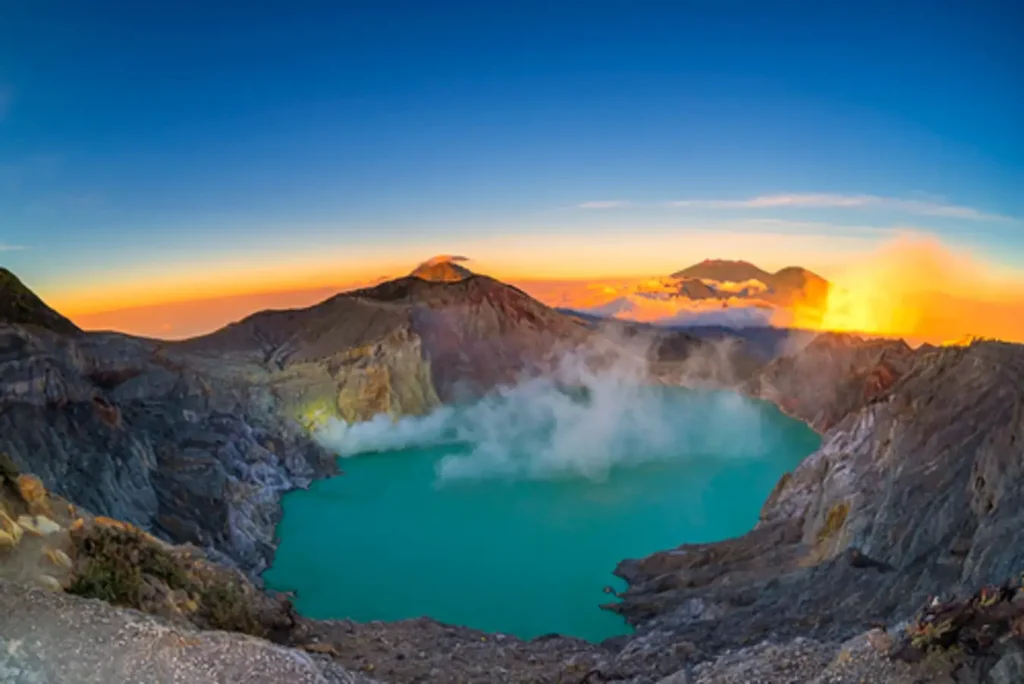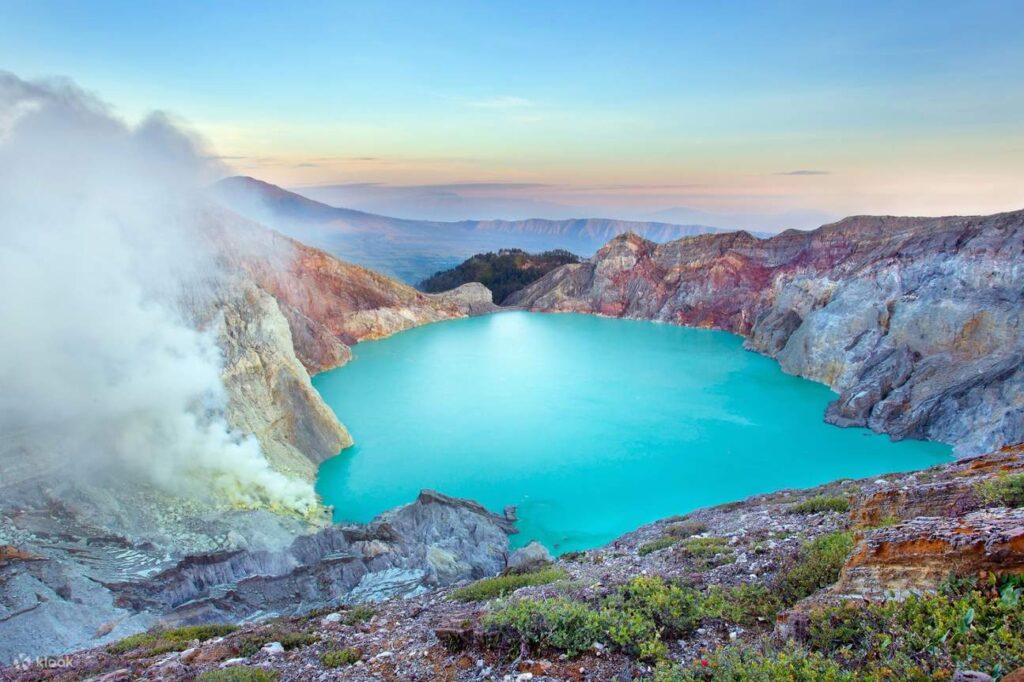Mount Ijen is a popular destination for nature lovers and adventure seekers. It is situated in East Java, Indonesia, and is known for its stunning landscapes, unique geological features, and active sulfur mining.
One of the critical aspects that visitors to Mount Ijen should consider is the temperature variations they can expect during their trip. Understanding Mount Ijen’s temperature is essential to prepare appropriately for the hike and enjoy the experience fully.
Key Takeaways
- Mount Ijen’s climate is unique and requires preparation for temperature variations.
- Understanding Mount Ijen’s temperature is crucial for a comfortable and enjoyable experience.
- In this article, we will provide a comprehensive guide to Mount Ijen’s temperature variations.
Understanding Mount Ijen’s Climate
Mount Ijen, located in East Java, Indonesia, has a unique and breathtaking climate. When planning a visit to this active volcano, it’s essential to understand the temperature variations you’ll experience during your trip.
The temperature at the Ijen Crater typically ranges from 10°C to 13°C, making it significantly colder than the average temperature of Mount Ijen, which is around 22°C to 25°C throughout the year. However, the temperature at the Ijen Volcano can drop drastically in the early hours of the morning when the blue fire phenomenon occurs.
The blue fire phenomenon is one of the main reasons visitors flock to Mount Ijen. To witness this surreal natural wonder, hikers must trek up the mountain before dawn. During this time, the temperature at the crater can drop to 3°C to 5°C, making it crucial to dress in layers to stay warm.
Overall, the best time to visit Mount Ijen is during the dry season, which is between April and October. During this time, temperatures are more comfortable for hiking and exploring. However, it’s still necessary to check the weather forecast before planning your trip, as heavy rains can cause temperature fluctuations.
Exploring the Blue Fire Phenomenon
One of the most mesmerizing sights at Mount Ijen is the blue fire phenomenon that can be witnessed at the crater. This natural wonder is caused by the combustion of sulfuric gases, which emerge from the cracks in the volcano at high temperatures.
For visitors hoping to witness this awe-inspiring sight, understanding the temperature conditions required is crucial. The blue fire can only be seen in the pre-dawn hours when the temperature at the crater drops below 150°C (302°F). When the temperature rises above this point, the gases ignite, and the blue fire disappears.
Once the sun rises, the temperature at the crater increases, and the blue fire is no longer visible. This means that the best time to witness the blue fire is during the early hours of the morning, before the sun has risen above the horizon.
Visitors should also note that the temperature at the crater can drop significantly during the pre-dawn hours, making it essential to dress appropriately. Warm clothing and sturdy footwear are a must for anyone hoping to make the trek to the crater in the early morning hours.
Best Time to Visit Mount Ijen
Choosing the best time to visit Mount Ijen is crucial to ensure an enjoyable and comfortable experience. The temperature can vary significantly throughout the year, and visitors must plan their trip accordingly.
The best time to visit Mount Ijen is between May and September when the temperature is relatively cooler, ranging between 11 to 20°C (51 to 68°F). During this period, visitors can enjoy the hike to the crater and the mesmerizing blue fire phenomenon comfortably. However, it is essential to note that this period is also peak tourist season, and visitors can expect larger crowds.
During the months of October to April, the temperature at Mount Ijen can reach as high as 32°C (90°F), making it challenging for visitors to hike to the crater, specifically during the daytime. However, this period is an excellent time to avoid crowds and enjoy the serene beauty of Mount Ijen.
Regardless of the time of year, it is essential to come prepared with warm clothing, especially during the sunrise hike, when the temperature can drop to as low as 5°C (41°F). Dressing in layers is recommended to adjust to the changing temperature conditions.
In summary, the best time to visit Mount Ijen from a temperature standpoint is between May and September, but visitors can enjoy the mountain’s unique beauty all year round with adequate preparation and planning.
Planning Your Sunrise Hike
When planning a sunrise hike at Mount Ijen, it’s crucial to prepare for the temperature variations that can occur during your ascent. The early morning temperatures can be quite chilly, so be sure to dress in layers to stay warm. As the sun rises, the temperature can quickly increase, so it’s essential to be able to adjust your clothing accordingly.
It’s recommended to wear a quality hiking jacket that is windproof and waterproof, as well as a hat and gloves to keep your extremities warm. As you start to warm up, you can remove layers to stay comfortable. It’s also a good idea to bring a backpack to store any extra clothing layers that you take off.
The temperature at the summit can vary greatly, so it’s important to be prepared for all conditions. At times, it can be quite windy and cold, so having a warm jacket and appropriate hiking gear is essential. As you descend, the temperature can drop again, so be sure to add layers back on to stay comfortable.
Overall, it’s crucial to prepare for the temperature variations during your sunrise hike at Mount Ijen. Dress in layers, wear quality hiking gear, and be prepared for all types of weather conditions. Doing so will ensure that you have a comfortable and enjoyable hike up this spectacular mountain.
Climate Factors at Ijen National Park
Mount Ijen is situated within Ijen National Park, which encompasses an area of over 190 square kilometers. The park is located on the eastern end of Java Island, close to the Bali Strait. Due to its location and altitude, the park experiences a unique climate that is entirely different from the rest of the island.
The temperature at Ijen National Park is strongly influenced by its altitude, which ranges from 1,600 to 2,799 meters above sea level. As elevation increases, the air density decreases, causing the temperature to decrease as well. This phenomenon is known as adiabatic cooling, which results in a drop in temperature of about 1 degree Celsius for every 100 meters of elevation gain.
In addition to altitude, the temperature at Ijen National Park is also influenced by several other environmental factors, including its proximity to the Bali Strait and the monsoon seasons. The park is located close to the coast, which ensures that the temperature remains relatively stable throughout the year. The coastal climate also brings in moisture-laden winds, resulting in high levels of rainfall throughout the year.
The park experiences two monsoon seasons each year, which significantly impact the temperature and weather conditions. The southwest monsoon, which occurs from May to September, brings dry weather and lower temperatures. The northeast monsoon, from October to April, brings in wetter weather and higher temperatures.
Visitors to Ijen National Park should be prepared for a climate that is typically cooler and wetter than the rest of the island. Temperature variations can be significant, with daytime temperatures ranging from 15 to 25 degrees Celsius and nighttime temperatures dropping to 10 degrees Celsius or lower.
Conclusion
In conclusion, Mount Ijen’s temperature variations play a crucial role in the overall experience of visiting this magnificent volcano. From the unique climate condition required for the mesmerizing blue fire phenomenon to the temperature fluctuations during the sunrise hike, understanding the temperature guide is imperative for visitors to have a comfortable and enjoyable trip.
By exploring the temperature range and average temperature of Mount Ijen, visitors can plan their trip to optimize their visit. The best time to visit Mount Ijen is during the dry season, which occurs from May to September. However, visitors should also prepare for the temperature fluctuations during the sunrise hike by dressing appropriately and bringing extra layers.
Additionally, the temperature at Ijen National Park is also influenced by various climate factors, such as altitude and geographic location. Visitors should take these factors into account when planning their trip to ensure they have a pleasant experience.
Plan Your Trip with the Ijen Temperature Guide
Overall, understanding the Mount Ijen temperature guide is essential for visitors to make the most of their trip. By considering the various temperature variations and factors influencing the climate at Ijen National Park, visitors can plan their visit accordingly and enjoy their time at this remarkable destination.
FAQ
What is the average temperature at Mount Ijen?
The average temperature at Mount Ijen ranges from 10 to 25 degrees Celsius (50 to 77 degrees Fahrenheit) throughout the year.
What is the temperature at the Ijen crater?
The temperature at the Ijen crater can vary from 5 to 15 degrees Celsius (41 to 59 degrees Fahrenheit). It is generally cooler at the crater due to its higher elevation.
What temperature conditions are needed for the blue fire phenomenon?
The blue fire phenomenon at Mount Ijen occurs when the temperature drops below 600 degrees Celsius (1,112 degrees Fahrenheit) and the sulfuric gases react with the air. It is often observed during the night or early morning hours when the temperature is lower.
When is the best time to visit Mount Ijen in terms of temperature?
The best time to visit Mount Ijen in terms of temperature is during the dry season, which typically falls between April and October. During this period, the weather is generally drier and the temperatures are more pleasant for outdoor activities.
What should I wear during the sunrise hike at Mount Ijen?
It is recommended to dress in layers for the sunrise hike at Mount Ijen as the temperature can vary significantly. Starting with a base layer, it is advisable to wear a long-sleeved shirt, a lightweight jacket or fleece, and long pants. It is also important to bring a hat and gloves to keep warm in the cooler temperatures before sunrise.
How do climate factors influence the temperature at Ijen National Park?
Various climate factors such as altitude, geographic location, and surrounding terrain influence the temperature at Ijen National Park. Higher elevations are generally cooler, and the park’s location near the equator means it experiences warm temperatures throughout the year. Additionally, the geography and surrounding vegetation can affect temperature variations within the park.





